
I. INTRODUCTION | II. PIERRE BOULEZ: NICOLAS DE STAËL, PAINTING & MUSIC | III. ANTON WEBERN: MUSIC HEARD BY NICOLAS DE STAËL
IV. ANTON WEBERN’S MUSIC: AN OVERVIEW
Painting & Music
NICOLAS DE STAËL: PAINTING, MUSIC, WEBERN, BOULEZ
Richard Jonathan
Richard Jonathan is the author of the literary novel Mara, Marietta: A Love Story in 77 Bedrooms
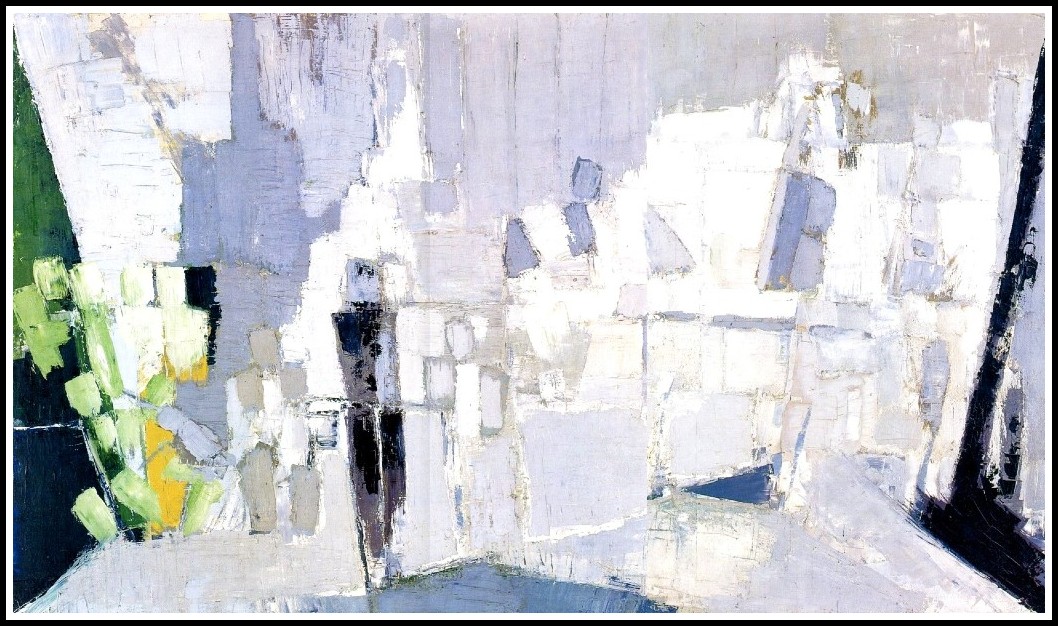
Nicolas de Staël, L’Orchestre, 1953
I. INTRODUCTION
Between Nicolas de Staël’s painting and Anton Webern’s music there is, at least to my eyes and ears, an evident affinity. Looking at Staël I hear Webern; listening to Webern, I see Staël. Rather than articulate my experience of the parallels between the two bodies of work, however, I will simply offer you, dear reader, the paintings and the music side by side so that your sensibility might make of them what it will. If, as Walter Pater asserted, all art aspires to the condition of music (wherein form and feeling, style and substance, manner and matter, are one) then Staël’s painterly apprehension of reality and visual expression of experience is on a par with Webern’s ‘eerily beautiful sonorities’, his ‘strange, lonely music’ which sovereignly attests that ‘one expresses in tones what can be said only in tones’. The theme of this post is painting and music, and to stimulate your own reflections on it, I offer you, in Part 2, my translations of Pierre Boulez’s views on the subject and his homage to Nicolas de Staël. In Part 3 I present, via Spotify, all the Webern music that Staël heard at a concert in Paris in March 1955, with a brief musical analysis of each piece by Susan Bradshaw. Finally, in Part 4, I offer an overview, by Joseph Machlis (from whom the quotations above are taken), of Anton Webern’s music. As for analysis and commentary on Nicolas de Staël’s painting, you will find a discussion of his place in art history and an evocation of him from my novel Mara, Marietta here, while in late September 2022, as part of the series ‘Art of the Portrait’, I will post my essay on Staël in the Mara Marietta Culture Blog.
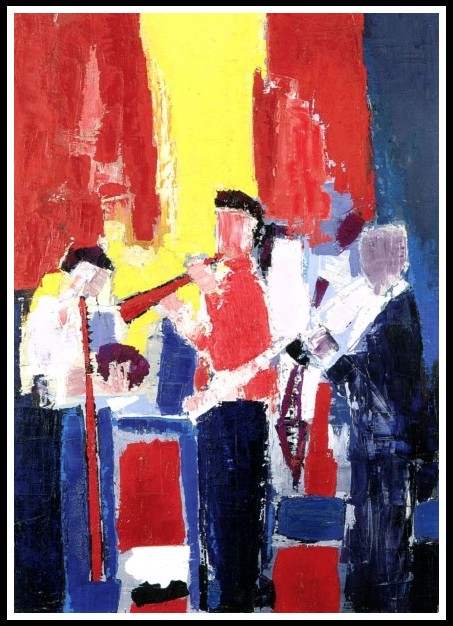
Nicolas de Staël, Musiciens, souvenir de Sidney Bechet, 1953
II. NICOLAS DE STAËL, PAINTING & MUSIC
Pierre Boulez
Translated from the French by Richard Jonathan
Sources: (1) Pierre Boulez, ‘Le souvenir de Nicolas de Staël…’, novembre 2002, in Nicolas de Staël (Paris: Éditions du Centre Pompidou, 2003) p. 12. (2) Selected extracts adapted from two interviews with Pierre Boulez published on 7 November 2008, one in Le Monde and the other in Télérama. All text in this section translated from the French for this post by Richard Jonathan.
Remembering Nicolas de Staël, I recall a period of both combat and naïveté, faith and doubt, certainty and calling into question, but more than that, I recall the very fruitful dialogues we had on the approaches, the investigations, and the interests we had in common. We did not take these literally, however, since they had a very distinct field of application.
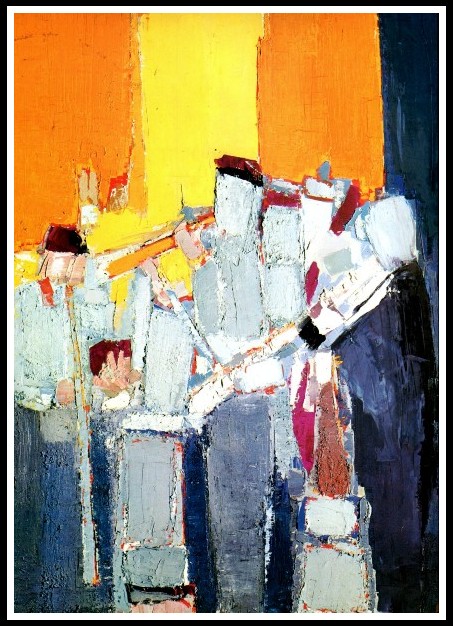
Nicolas de Staël, Les musiciens, 1953
In fact, as regards his interest in the discoveries of the music of his time, Nicolas de Staël was an exception. Indeed, the osmosis between music and painting and their respective practitioners was extremely rare. Very often, the painters were either deaf to music or relegated it—be it art music or pop-rock—to a background role. Nicolas de Staël, in contrast, drew resources for invention from the most recent music heard in those years (the 1950s), thanks to a transposition entirely personal to him. He did so instinctively, of course, but also by deeper, more deliberate reflection. He appreciated Stravinsky, certainly, but found the music of the Second Viennese School much more intriguing. Like all of us, he discovered this new music at performances that, for the most part, were premieres.
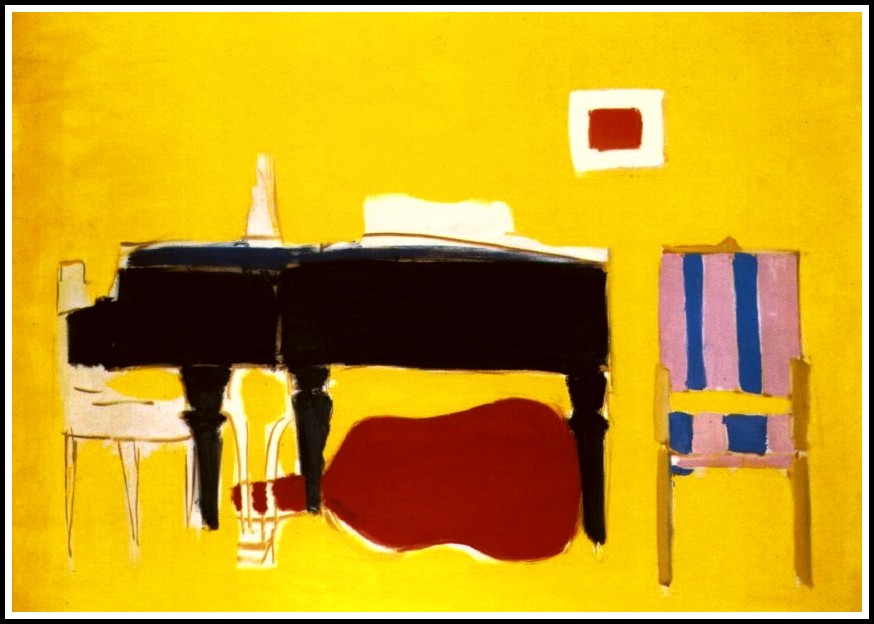
Nicolas de Staël, Le Piano, 1955
If Berg and Schoenberg struck Nicolas de Staël as important, it was Webern who most intrigued and stimulated him. In that he was not alone, for he was participating in the way of thinking and perceiving of a certain generation. It is no coincidence that among the most significant of his last paintings are ones evoking music and the instruments that produce it, a kind of visualization of the concert via a transposition of the sonorous: not an abstract, literal transcription as one can find in Paul Klee, for example, but rather a ‘revelation’ of the instruments through a greatly stripped-down structure. These ‘musical’ paintings were made at a turning point in the artist’s evolution, and they play an extremely powerful and revealing role in it.
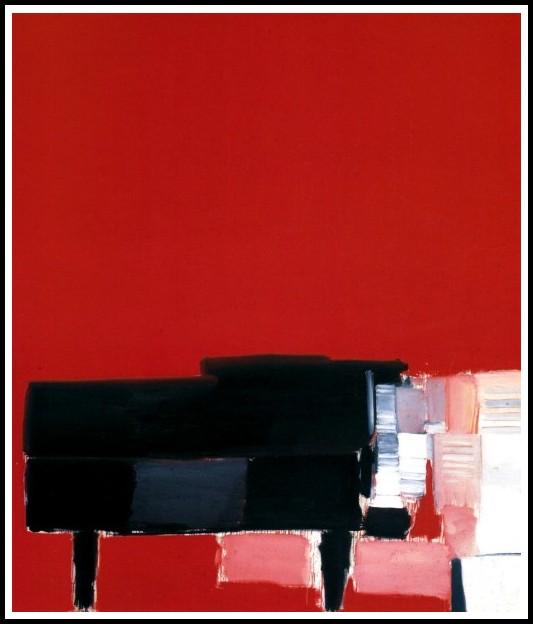
Nicolas de Staël, Le Concert, 1955 (detail)
Alert to the trap of the decorative in the purely abstract, Nicolas de Staël increasingly tried to anchor himself in the real while ceding nothing to it in terms of structure and design. It is the attempt to resolve this antinomy that captivated him in Webern, the relation between motif (theme, shape) and structural organization. He saw it at once as an essential justification for geometry and as a requirement to loosen that geometry to facilitate representation and expression.
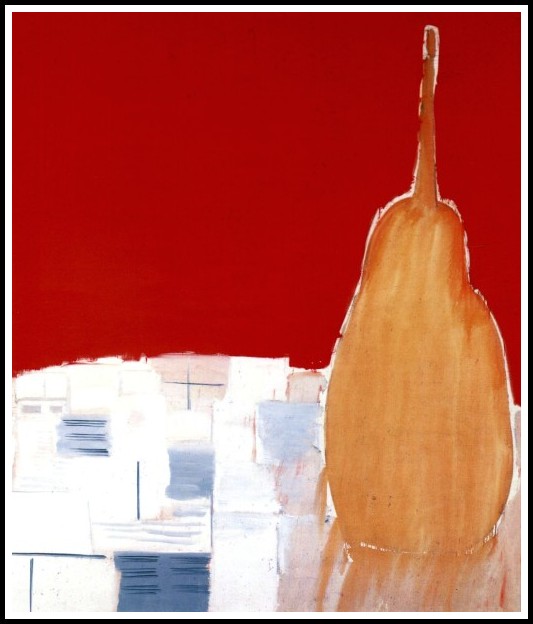
Nicolas de Staël, Le Concert, 1955 (detail)
It was then that Nicolas de Staël left us, shortly after having heard two concerts given by Domaine musical and devoted to Webern and Schoenberg, concerts that had held him spellbound and marked him deeply. The discussions about the works we had heard immediately after the performance were both intense and highly stimulating. So much so that it is on two accounts, personal and artistic, that I regretted his all-too-sudden death, a death which came a time when his reflections had brought him to a crucial point in his development.
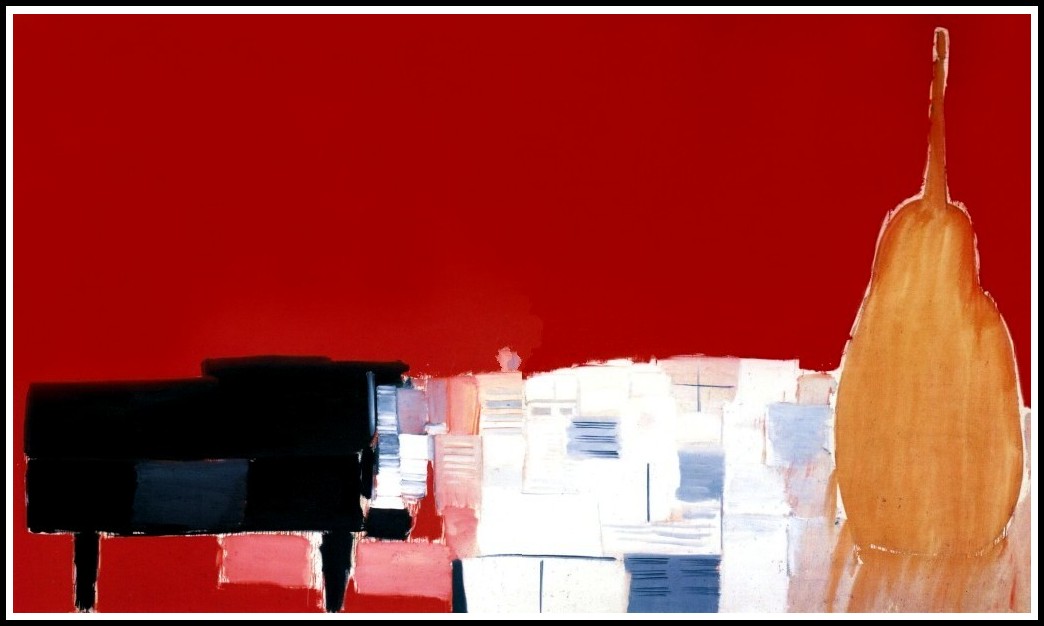
Nicolas de Staël, Le Concert, 1955
I met Nicolas de Staël thanks to Mme Tézenas, the patroness of the Domaine musical. I knew his painting, but I didn’t know he was passionate about music—not simply keen on music, but passionate about it. It was very important to him. He was particularly interested in contemporary music. This contrasts with Kandinsky, for example, whose relations with Schoenberg were difficult. In the beginning, Kandinsky wrote to Schoenberg, importuned him, invited him to the Bauhaus. Then their relations broke down. Paul Klee didn’t like the music of his time either. He turned his back on Schoenberg and Stravinsky, took refuge in Mozart, Haydn, and Beethoven. Delacroix, for his part, couldn’t handle Beethoven, and detested Berlioz. He fell back on Mozart. All these painters were risk-takers, but in music they played is safe. They preferred the old to the new. Non-musicians did find John Cage attractive, but he had more ideas than actual music.

Delacroix (self-portrait, 1837) & Berlioz (Courbet, 1850) | Schoenberg (Man Ray, 1927) & Kandinsky (Erfurth, 1933) | Stravinsky (Gleizes, 1914) & Klee (self-portrait, 1933)
Vieira da Silva showed me some of her paintings. They had a very complex geometry. After a certain time, she inserted blanks into them, to erase the geometry or to make it reappear, I don’t know. That sparked specifically musical ideas in me. Having a musical texture and making a hole in it, for example, with a segment of notes that is not played, those are blanks that make the structure lighter, harder to ‘read’.
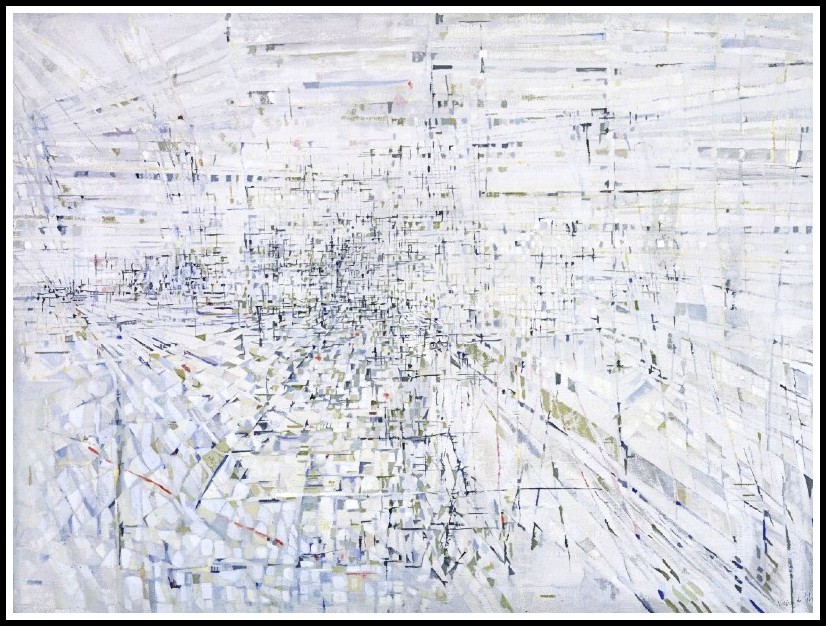
Maria Helena Vieira da Silva, The City, 1950-51
I’ve got a picture of trees by Cézanne in my mind’s eye. Is it an exercise, a preparatory watercolor for what he will do later in oil, or is it sufficient unto itself? He never exhibited this watercolor, he always kept it for himself. With our vision today, we may wonder whether, in certain of his paintings, he did not hem himself in too tightly in his vision, a vision that, in his watercolors, was freer, more spontaneous and swifter. Is this watercolor perhaps more important than a finished painting? This is the question I ask myself—the question of the finished work and the fragment, the degree of elaboration. As a composer, I find the process of creation at least as interesting as the completed piece, because it generates more ideas than the final work. Admittedly, that’s a stance the audience wouldn’t share.
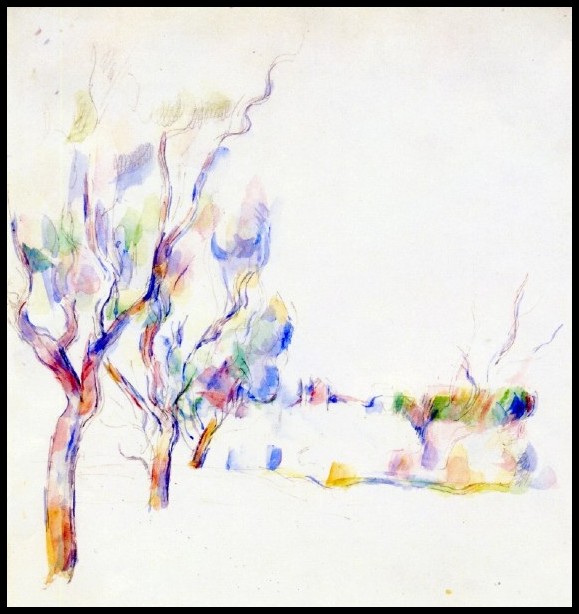
Cezanne, Almond Trees, Provence, 1900
Painters and composers live in different spheres, distant from each other. Debussy never mentions Monet, yet is there any painter closer to his Reflets dans l’eau than the painter of the Nymphéas? Aside from the décor for his ballets and operas that Diaghilev commissioned from them, neither Picasso nor Braque nor Matisse showed any interest in the music of their time. One may be tempted to link up Webern and Mondrian, for their shared rigor and economy of means, but the painters that Webern admired and the music that Mondrian liked were second rate. During the period when Domaine musical gave concerts (1954-1973), I was able to rally very few painters to our adventure. There were, nevertheless, a few regulars; naturally, I asked them to illustrate our album covers—Miró gave an engraving for our recording of Oliver Messiaen’s Oiseaux exotiques. The most assiduous among them, André Masson and Vieira da Silva, also contributed. Before his tragic suicide, Nicolas de Staël drove up from the south of France, where he was living, to attend the first Domaine musical concerts. We had long discussions about what distinguished Schoenberg’s music from Webern’s.
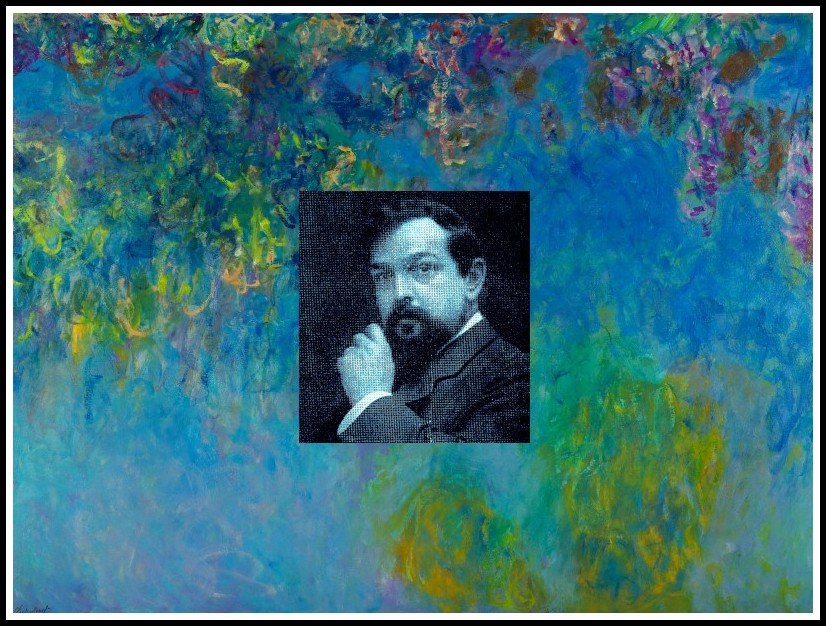
Claude Monet, Wisteria, 1925 | Claude Debussy, Bibliothèque nationale de France
While creating, composers become predators, appropriating whatever may stimulate their imagination. In Paul Klee’s paintings, for example, I had noticed very finely-textured backgrounds, thoroughly worked, from which incisive, sharply-contoured graphic figures seemed to tear themselves. In my orchestrations, I preserved this contrast between an opaque, undifferentiated sonic background and very precise, very brilliant, cleanly detached motifs.
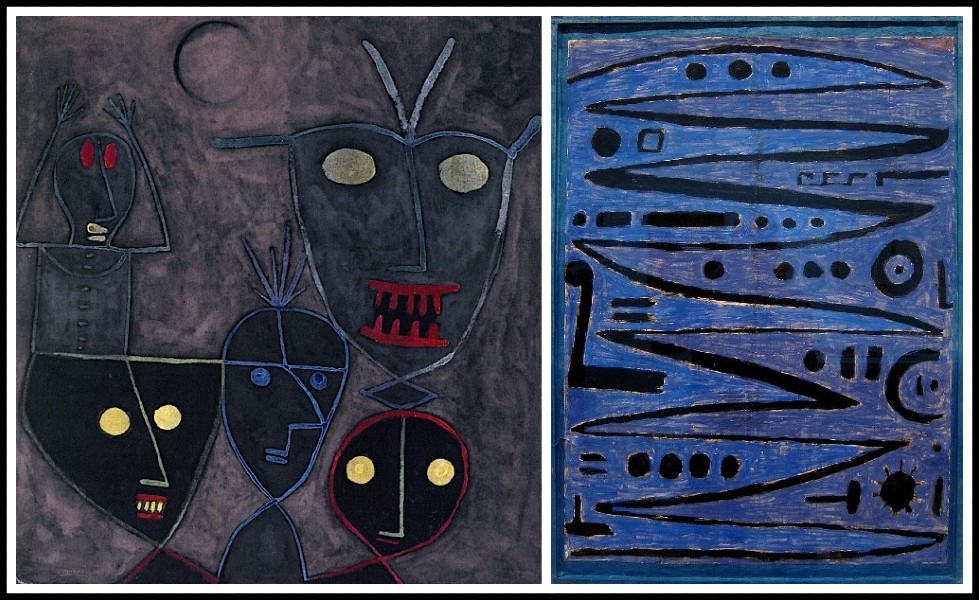
Paul Klee: Demonic Puppets, 1929 | Heroic Strokes of the Bow, 1935
Generally speaking, I’m attracted to labyrinthine works, like James Joyce’s novels or Jackson Pollock’s action paintings. In Vieira da Silva’s work, for example, I have always liked those abstract monuments that emerge from the fog only to be drowned in a layer of white when their architecture becomes too apparent. That gave me the idea, in several pieces, of erasing obvious structures by disguising them in a sort of instrumental fog. When I told her I had done this, not only did she not hold it against me, she gave me one of her paintings featuring this phenomenon.
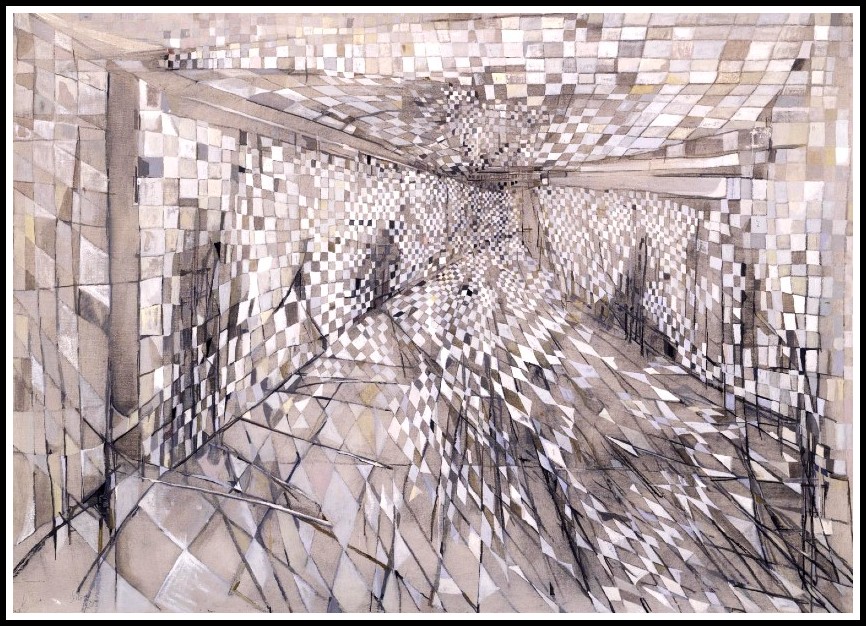
Maria Helena Vieira da Silva, The Corridor, 1950
III. ANTON WEBERN: AN OVERVIEW OF HIS MUSIC
Joseph Machlis
From Joseph Machlis, Introduction to Contemporary Music, 2nd edition (NY: W.W. Norton, 1979) 271-75
Webern responded to the radical portion of Schoenbergian doctrine, just as Berg exploited its more conservative elements. Of the three masters of the modern Viennese school, he was the one who cut himself off most completely from the tonal past. Indeed, he has been called the only real atonal composer, as he never accepted even the limited coexistence of tonal and atonal elements which is to be found in the works of Schoenberg and Berg. Webern developed an extremely novel and personal style, yet one that was neither capricious nor arbitrary, for it represented the most minute working out of the principles upon which he based his art.
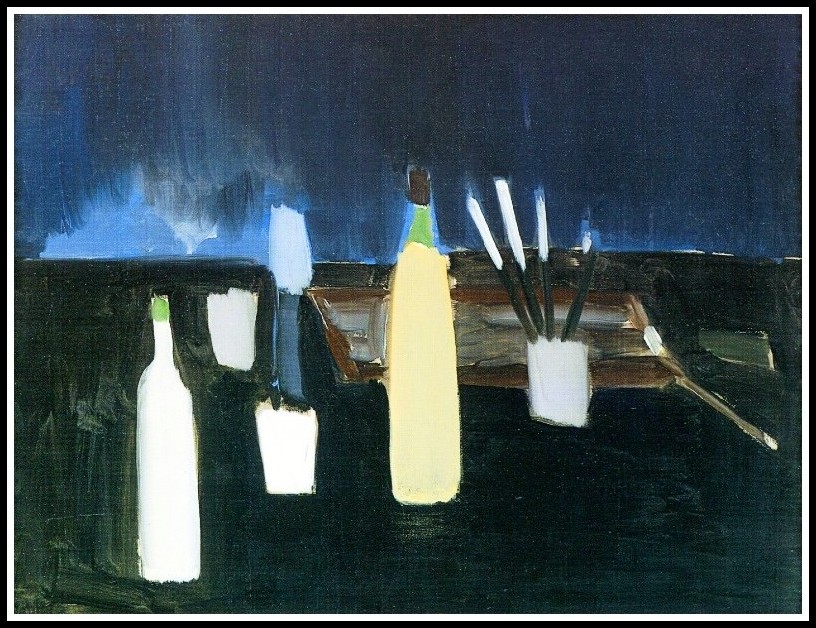
Nicolas de Staël, La Table de l’artiste, 1954
This style evolved toward an ideal of the utmost purity and economy in the articulation of musical thought. Building upon the Schoenbergian doctrine of perpetual variation, Webern suppressed all repetition of material. ‘Once stated, the theme expresses all it has to say,’ he wrote. ‘It must be followed by something fresh.’ This belief embodied his desire for continual renewal in the creative process and his attempt to achieve ever fresh invention. The Schoenbergians abandoned the spacious Classical forms in favor of extreme compression. Webern carried this urge for brevity much farther than either of his comrades.
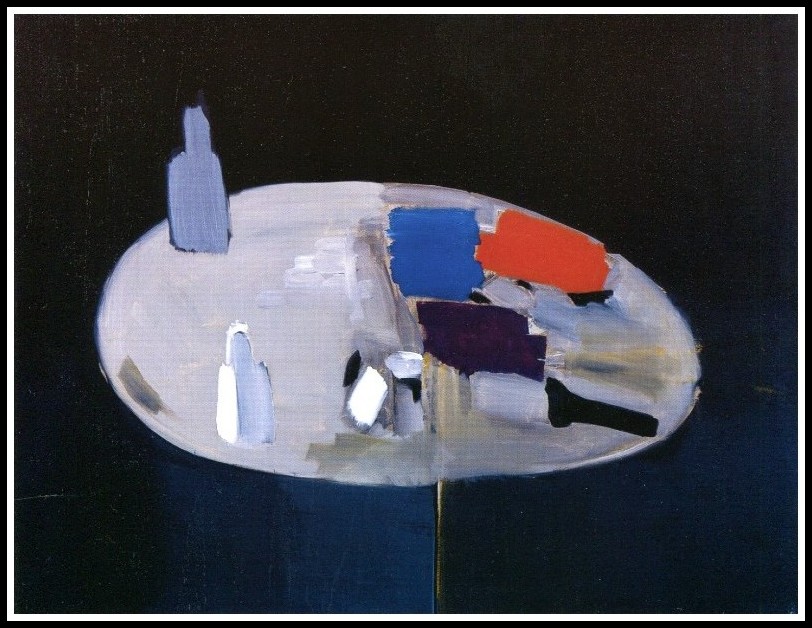
Nicolas de Staël, La Palette, 1954
Such conciseness seems to nullify the very notion of time as we have come to understand it in music. The composition is over almost before we are aware that it has begun. This economy of utterance, which carried to hitherto unimagined extremes the twentieth-century desire for the exclusion of nonessentials, answered a real need of Webern’s temperament. The Six Bagatelles for String Quartet, Opus 9, have been well characterized as ‘melodies in one breath.’ Arnold Schoenberg wrote of them: ‘Think of the concision which expression in such brief forms demands! Every glance is a poem, every sigh a novel. But to achieve such concentration—to express a novel in a single gesture, a great joy in a single breath—every trace of sentimentality must be correspondingly banished.’
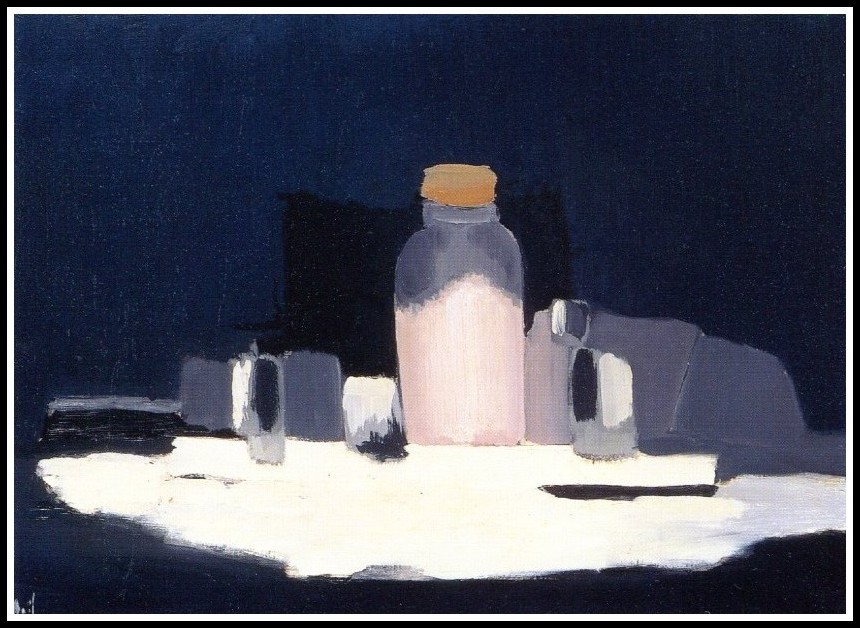
Nicolas de Staël, Le Bocal, 1955
Hardly less novel is the musical fabric in which Webern clothed his ideas. His inordinate sensitivity to sound went hand in hand with what Henry Cowell has called ‘an almost frighteningly concentrated interest in the possibilities of each individual tone.’ This caused him to place the utmost expressive value on each sonority. His scores call for the most unusual combinations of instruments. Each tone is assigned its specific function in the overall scheme. The instruments, used in their extreme registers, frequently play one at a time, and very little. This technique results in an extreme attenuation—one might call it atomization—of the musical fabric, which confers upon the individual sonority an importance it never had before. A four-tone chord will be distributed among as many instruments playing in four different registers. Webern applied Schoenberg’s principle of the non-repetition of pitches to color. There are passages in his works where each tone in a melodic line is played by a different instrument. This procedure, of course, can be traced back to the Schoenbergian concept of Klangfarbenmelodie or ‘tone-color melody.’ When no instrument is allowed to play more than one or two notes of a theme in succession, the changing timbre takes on almost a melodic value; indeed, in such passages the color is at least as important as the pitch.
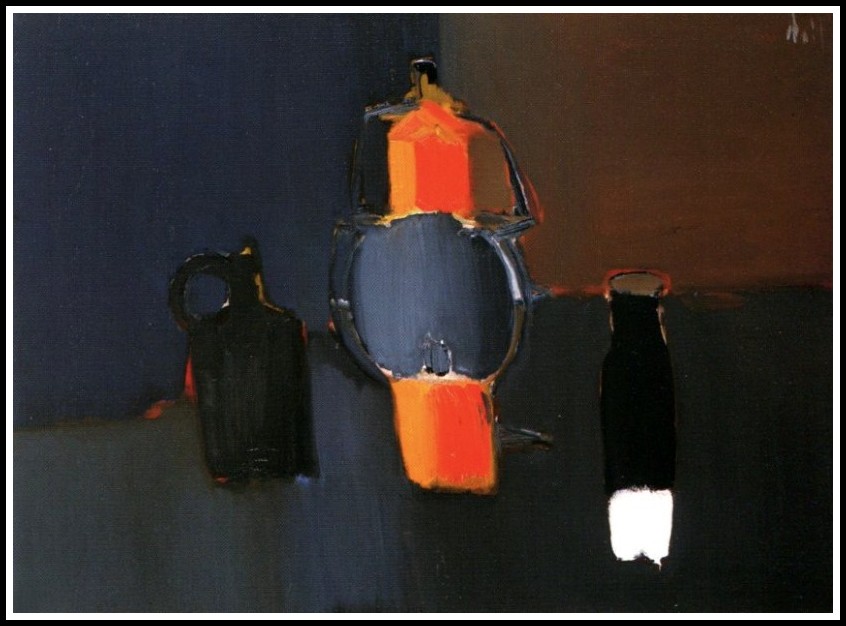
Nicolas de Staël, Lanterne et Pichet, 1955
This preoccupation with sound for sound’s sake is, of course, one of the hallmarks of the contemporary approach to music. Webern’s works abound in the most delicate effects, with much contrast between muted and unmuted instruments, the division and subdivision of strings, pianissimo trills and tremolos, and the most precise instructions as to how the individual tone is to be produced. His sensitivity to timbre is matched by the subtle dynamic level at which he pitches his discourse. There are passages that are no more than a whisper. A superabundance of rests serves to set off the individual tones. This is music in which silence is hardly less expressive than sound. The rhythmic designs through which the material is presented are of the most elusive. The single phrases have their special character and coherence; but the metrical scheme is not readily apparent. Webern’s deliberate avoidance of strongly accentuated patterns, his way of placing the weightier sounds on the offbeat and of perpetually varying the rhythmic phrase imparts to his music its indefinable quality of ‘hovering suspension,’ of immobility.
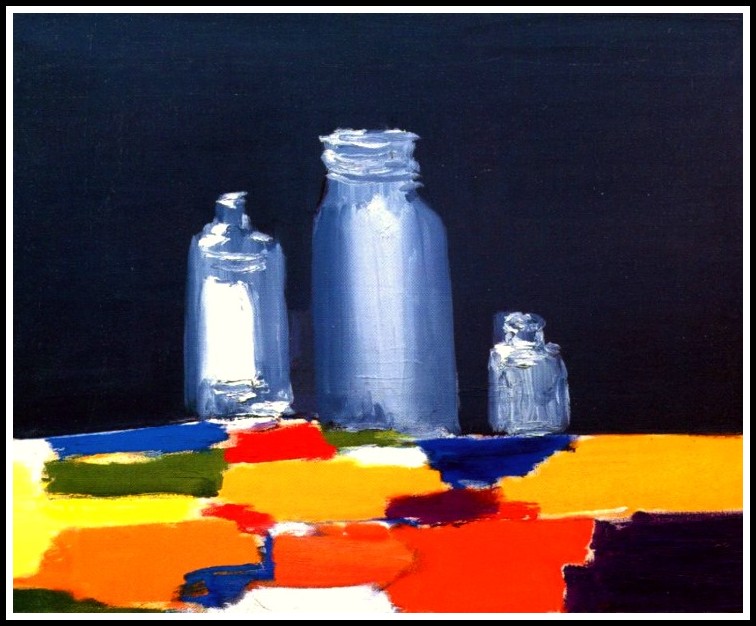
Nicolas de Staël, Nature morte aux bocaux, 1955
The effect of discontinuity is strengthened by the wide leaps in the melodic lines of both his vocal and instrumental music. A pointillism so rarefied needed a strong structural sense to sustain it if it were not to degenerate into the flimsiest impressionism. From his earliest works Webern displayed a constructive sense whose logic and power grew with each successive composition. Underlying the disembodied sound is a firmly knit architecture based on interval proportion and projected in musical space by the most careful ordering of all its elements. The interval became the basic structural element in Webern’s music, ultimately taking the place of the theme. Major sevenths and minor ninths, major and minor thirds and their derivatives are the most important intervals in his music. Beneath the evanescent sound is the hard core, the cutting edge. Hence the aptness of Stravinsky’s comparison with diamonds.
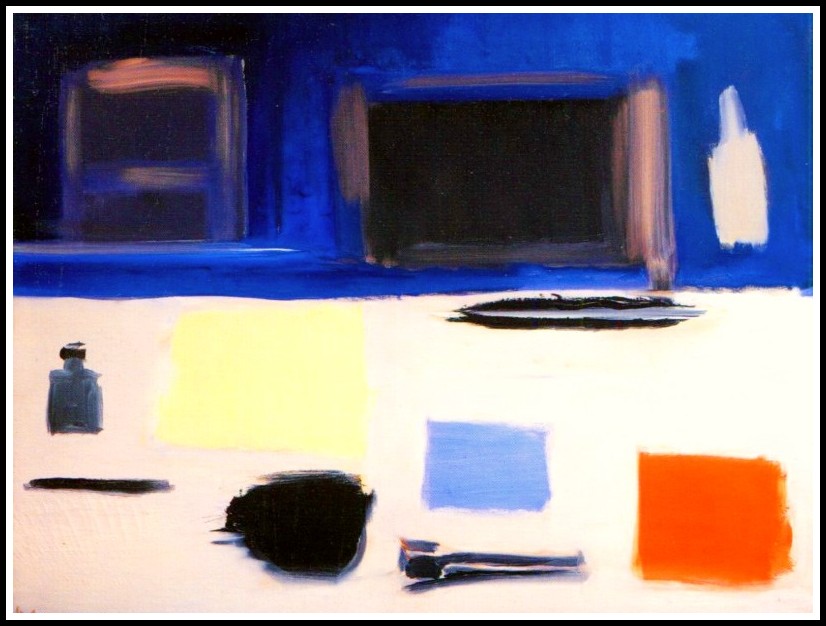
Nicolas de Staël, Nature morte à la table, 1955
The music of Webern’s formative period shows the influence of Schoenberg; yet he took only what could nourish his personal style, and soon diverged from his master in order to enter a domain uniquely his own. A number of early works have recently been discovered and published, but Webern’s official debut was the Passacaglia for Orchestra, Opus 1. This was followed by a number of significant works: Five Movements for String Quartet, Opus 5 (1909); Six Orchestral Pieces, Opus 6 (1910); Six Bagatelles for String Quartet, Opus 9 (1913); and Five Orchestral Pieces, Opus 10 (1913). These were flanked by the poetic songs—some with piano, others with instrumental accompaniment—in which Webern’s essentially lyric gift found a congenial outlet.
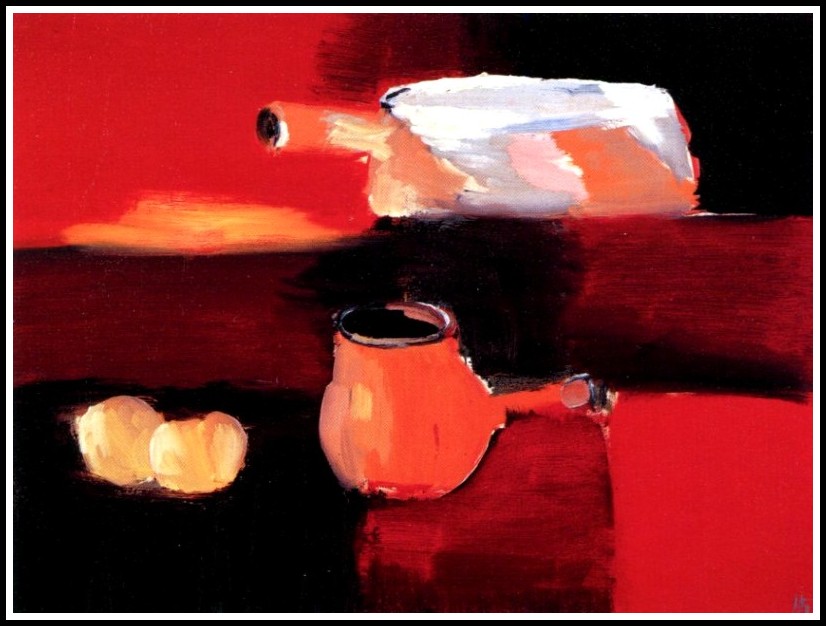
Nicolas de Staël, Nature morte au poêlon blanc, 1955
Once he had carried the art of aphorism to a limit beyond which there could be only total silence, Webern had to turn back in the direction of more extensive forms. He found the answer to his structural problem in the twelve-tone method. He adopted this in his Opus 17, the Three Sacred Folk Songs for voice, clarinet, bass clarinet, and violin (1924); and he remained faithful to it for the rest of his life. Within the framework of the dodecaphonic system he evolved a style of writing based upon the most intellectual disciplines of the art of counterpoint. The close-knit texture of his music represents the summit of musical economy. In this motivic fabric, concentration of thought and purity of style are carried to the furthest point. The devices of canonic writing are handled with true virtuosity. Double canons in contrary motion are common occurrences in Webern’s music. His fondness for structural abstraction led him into intricacies which rival those of the medieval contrapuntists.
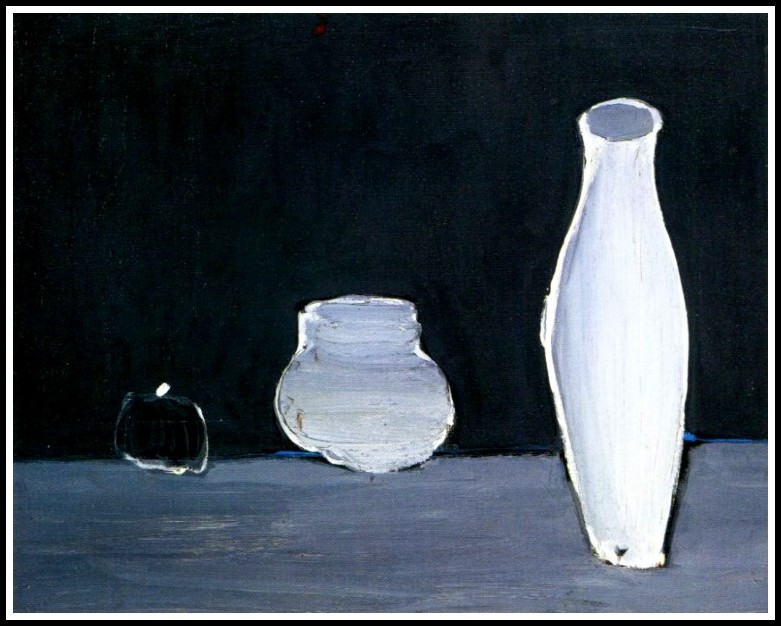
Nicolas de Staël, Nature morte en gris, 1954
With his Symphony, Opus 21 (1928) Webern came into his fully matured style. In this and the works that followed, the twelve-tone technique is used with unprecedented strictness; the material is made to create its own forms. To this last period belong the Quartet for violin, clarinet, tenor saxophone, and piano, Opus 22 (1930); the songs of Opus 23 (1934) and Opus 25 (1935); the Concerto for Nine Instruments, Opus 24 (1934); and Das Augenlicht (The Light of Our Eyes), Opus 26 (1935), for mixed chorus and instrumental ensemble. From these years date also the Piano Variations, Opus 27 (1936); String Quartet, Opus 28 (1938); and Webern’s last three works: two cantatas for solo voices, chorus, and orchestra, Opus 29 (1939) and Opus 31 (1943); and the Variations for Orchestra, Opus 30 (1940). These reveal a master who has vanquished the most complex problems of counterpoint, and who uses his mastery to achieve the Schoenbergian goal of deriving ‘an abundance of thematic forms from the least possible musical material in the smallest possible space, while at the same time holding these forms to a strict unity.’
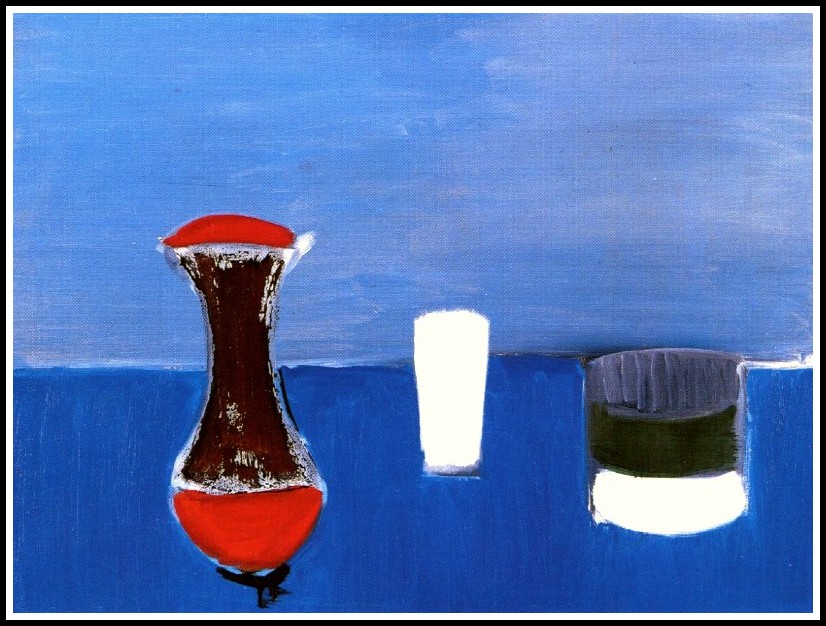
Nicolas de Staël, Nature morte, 1954
Schoenberg had contented himself with an organization based upon fixed series of pitches. Webern extended this concept to include timbre and rhythm. Therewith he moved toward complete control of the sonorous material—in other words, total serialization. His disciples, for instance Pierre Boulez and Karlheinz Stockhausen, have carried the implications of Webern’s music to its furthest consequences by applying the serial technique to pitches and rhythms, timbres, dynamics, and densities. As a result, Webern emerged as the dominant figure in dodecaphonic thinking at the middle of our century.
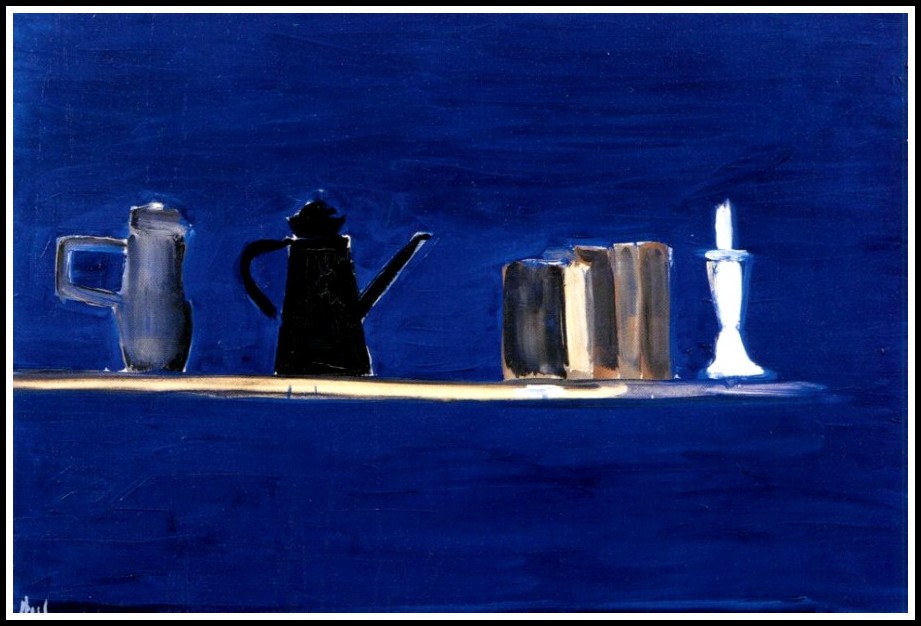
Nicolas de Staël, Nature morte au fond bleu, 1955
Webern’s mature output was thirty-one works, all recorded on four long-playing records. This is not much to show for a creative activity that extended over thirty-five years, but the music is so carefully calculated that it impresses one as having been written at the rate of a few notes a day. Many of the inner relationships that hold it together—the canons, retrograde forms, and inversions—are hardly discernible to the ear. They concern the twelve-tone initiate rather than the ordinary listener. However, one need not be aware of the technical complexities to savor the eerily beautiful sonorities that flow from this strange, lonely music. They evoke the remote region inhabited by Webern, a region that only a few will choose to enter. ‘They alone will understand these pieces,’ wrote Schoenberg, ‘who hold the faith that one expresses in tones what can be said only in tones. Subtle, indeed, are the senses that can differentiate here. Fine is the mind capable of finding pleasure in things so recondite!’
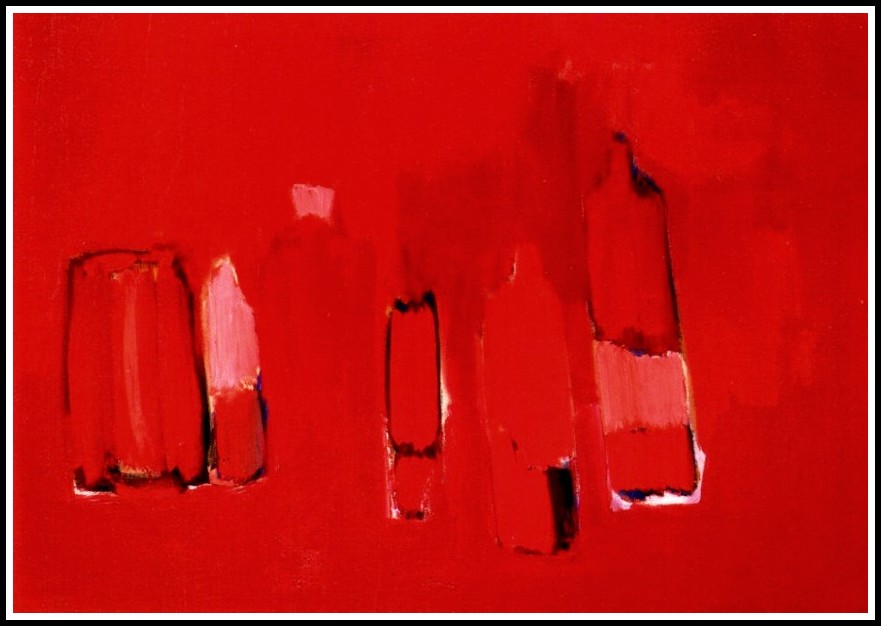
Nicolas de Staël, Bouteilles rouges, 1955
IV. ANTON WEBERN: MUSIC HEARD BY NICOLAS DE STAËL
Musical Analysis by Susan Bradshaw
From the liner notes to the 1991 Sony Classical CD, Webern: Complete Works, Opp. 1-31. Pierre Boulez.
Webern Concert Programme – Paris, 5th & 6th March 1955 – Pierre Boulez, Domaine musical
Source: Sarah Barbedette, Poétique du concert: A la lumière du tableau de Nicolas de Staël (Paris: Fayard, 2014)
1. Five Movements for String Quartet, Op. 5 (1909, 1930)
2. Concerto for Nine Instruments, Op. 24 (1934)
3. ‘Das Augenlicht’, Op. 26 (1935) lyrics
4. Five Pieces for Orchestra, Op. 10 (1913)
5. Symphony, Op. 21 (1928)
6. Two Songs, Op. 19 (1926)
7. Variations for Orchestra, Op. 30 (1940)
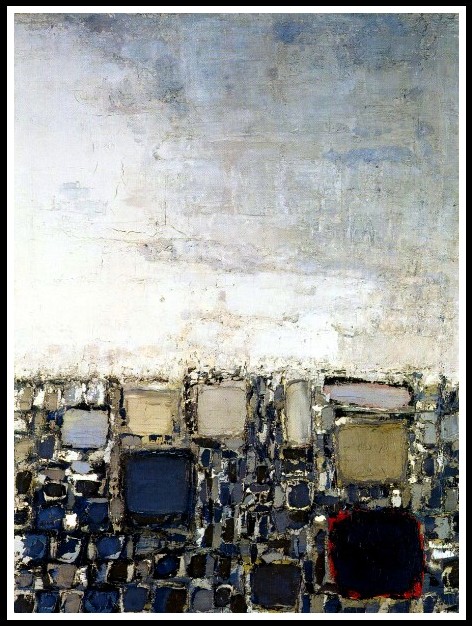
Nicolas de Staël, Les Toits, 1952
1. ANTON WEBERN, FIVE MOVEMENTS FOR STRING QUARTET, OP. 5 (1909)
Although these pieces show signs of having been influenced by early Schoenberg (particularly the string textures of his Quartet No. 2 in F sharp minor, Op. 10), they also – and more significantly – foreshadow the later, aphoristic sound world of his Six Little Piano Pieces, Op. 19. This is especially true of the short-lived phrasing, restrained ostinati and muted dynamic range of the second, fourth and fifth movements. On the other hand, the more extrovert expression of the first and third pieces is characterized by dynamic extremes – and the relatively extended structure of the first piece seems to be taking a last nostalgic look at an expansiveness which was shortly to become quite irrelevant to Webern’s musical thinking.
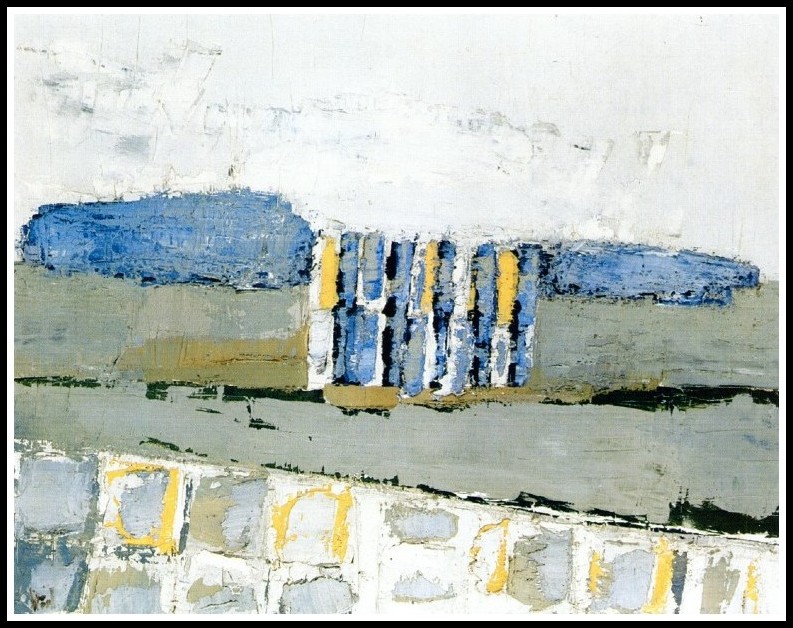
Nicolas de Staël, Grignan, 1955
2. ANTON WEBERN, CONCERTO FOR NINE INSTRUMENTS, OP. 24 (1934)
This Concerto is a supreme example of Webern’s strict (strictly musical) application of disciplined procedures and of his continued striving for the perfection of ‘comprehensibility, the ultimate principle in the presentation of musical thought’. This clarity of presentation as achieved by an absolute ‘rightness’ of internal balance, ‘by relating everything to what is already present in the principle part: by repeating it in various combinations, by introducing the course of thematic events not only horizontally but also vertically; by aspiring towards an all-embracing unity, deriving as much as possible from one principal idea’.
This is music of small dimensions, shorn of all expansive gestures and of any desire to create musical ‘vistas’. In the first movement, tiny, three-note motifs (all of which are interrelated in melodic structure) are rhythmically defined in notes of varying lengths, and articulated with every conceivable differentiation of attack by the single-line instruments – as well as being formed into chords on the piano. A continual ebbing and flowing of the tempo punctuates the phrase-endings – characterizing the movement with a restless energy.
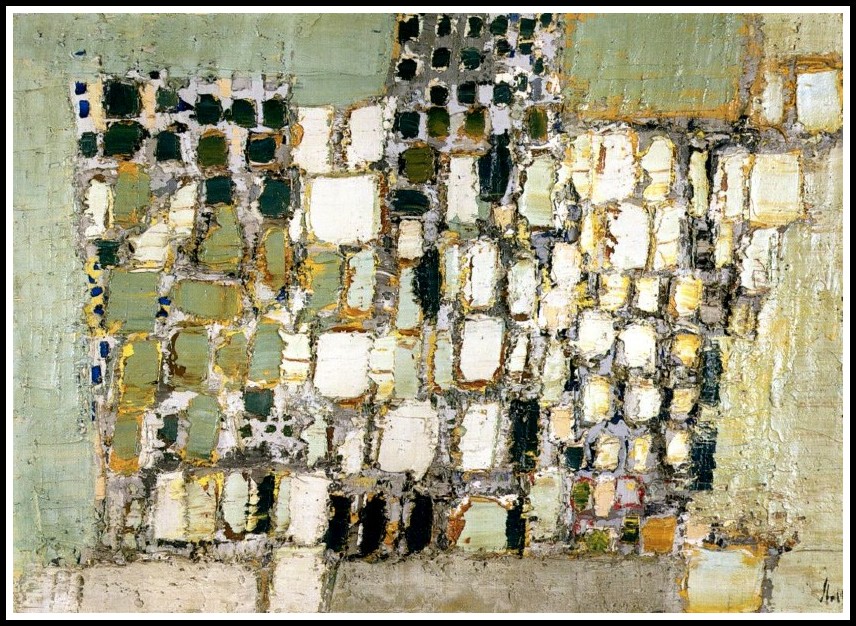
Nicolas de Staël, Composition, 1951
In the subdued Adagio of the second movement, the same melodic material is so organized that the slow-moving piano chords (which are often grouped in threes, across the two-beats-to-the-bar rhythm of the governing pulse) form a background entirely built from intervals of thirds and sevenths. These chords provide the central thread around which the other instruments trace a widely-spaced melody of contrasting colours. As in the first movement, shapes, pitches and melodic figurations return in a quasi recapitulatory manner – but only with the purpose of placing themselves in yet other contexts.
The third movement is an abrupt reversal of mood: its springing staccato attacks and syncopated rhythms approach a brash abandon – especially in the insistently misplaced accents of the fortissimo coda – which is unique in Webern’s output. The three-note motifs and chords are as evident here as in the previous movements, so that the work as a whole has unity of a set of variations – being three different characterizations of the same threefold idea.
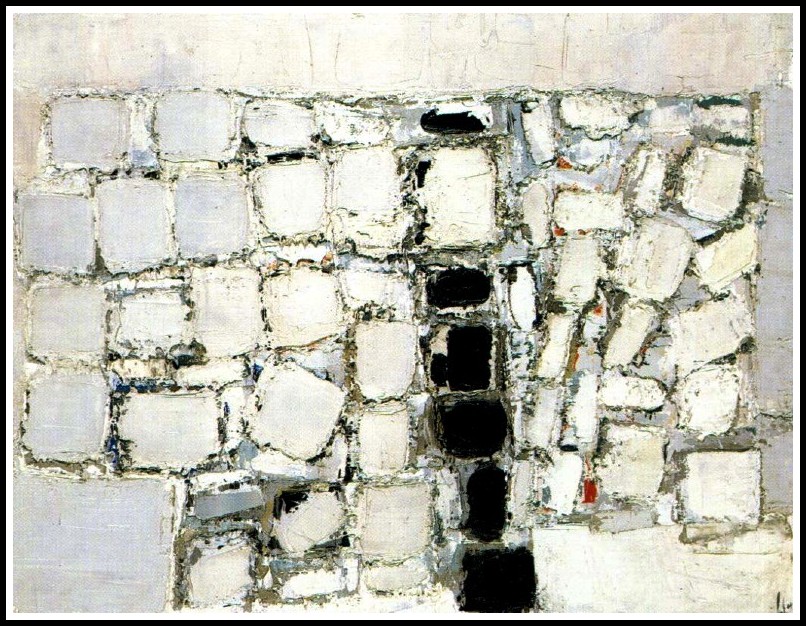
Nicolas de Staël, Composition, 1951
3. ANTON WEBERN, ‘DAS AUGENLICHT’, OP. 26 (1935)
Das Augenlicht is the first of the three works for voices and orchestra which Webern wrote during the last ten years of his life. The chorus unwinds the main thread of the musical argument, the orchestra serving to introduce, separate, punctuate and occasionally comment upon the verses of the poem. The tempo is slow and the instrumentation sparse throughout, except for a brief central episode. Canonic writing contrasts with four-part harmony and with unison melodies passed from one voice of the chorus to another: the music of Das Augenlicht affirms the nature of the poem by its very refusal to ‘illustrate’ – by allowing the words to exist, in their own right, as on a separate plane.
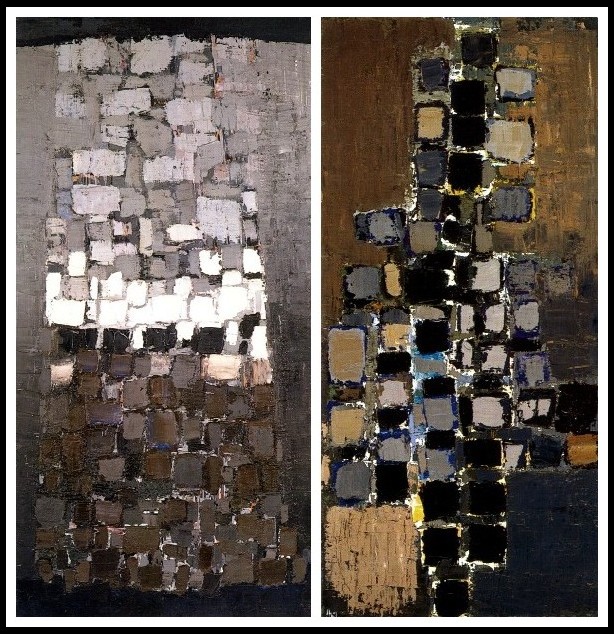
Nicolas de Staël, Composition, 1951
Das Augenlicht | Hildegard Jone
Das Augenlicht
Durch unsere offnen Augen
fliesst das Licht ins Herz
und strömt als Freude sanft
zurück aus ihnen.
lm Liebesblick quillt mehr herauf
als je herabgedrungen.
Was ist geschehen,
wenn das Auge strahlt?
Sehr Wunderbares
muss es uns verraten:
Dass eines Menschen Innerstes
zum Himmel ward
mit soviel Sternen
als die Nacht erhellen,
mit einer Sonne,
die den Tag erweckt.
O Meer des Blickes
mit der Tränenbrandung!
Die Tropfen, welche sie versprüht
auf Wimpemhalme,
vom Herzen und der Sonne
werden sie beschienen.
Wenn sich die Nacht der Lider
über deine Tiefen
still niedersenkt,
dann spülen deine Wasser
an die des Todes:
deiner Tiefen Schätze,
die tagerworbnen
nimmt er sacht mit sich.
Jedoch aus seinen unergrundlich
dunklen Tiefen,
wenn mit den Lidern
sich der Tag erhebt,
ist manches seiner Wunder
in den Blick, den neuen,
heraufgeschwommen
und es macht ihn gut.
The Light of Our Eyes
Through our open eyes
light streams into the heart,
then tenderly streams back from them
as joy.
In love’s glance more light issues forth
than ever entered.
What has occurred
that makes the eyes so radiant?
It must be something very wonderful
that they betray to us:
that a human creature’s inmost self
has become like heaven
with as many stars
as brighten the night,
with a sun
which awakens the day.
O sea of glances
with its surf of tears!
The droplets which it sprays
on the blades of your eyelashes
are shone upon
by the heart and by the sun.
When the night of your lids
quietly descends
upon your depths,
your waters lap
against those of Death:
the treasures of your depths,
gathered during the day,
he gently takes away with him.
Yet, from his unfathomable,
dark depths,
as with your rising lids
day dawns,
some of his mystery
has ascended into your glance,
the new one,
and it makes it good.
La lumière de nos yeux
Par nos yeux ouverts,
la lumière coule dans notre cœur
et sous forme de joie
s’échappe d’eux à nouveau doucement.
Du regard d’amour s’échappe davantage
qu’il n’est jamais entré.
Que s’est-il produit
quand l’œil rayonne?
C’est quelque chose de très extraordinaire
qu’il doit nous trahir:
que d’un homme, le plus profond
est devenu ciel
avec autant d’étoiles
que dans une nuit claire,
avec un soleil
qui réveille le jour.
O mer du regard
avec ton tumulte de larmes!
Les gouttes qu’il projette
sur la paille de tes cils,
sont éclairées
par le cœur et le soleil.
Quand la nuit des paupières
sur tes profondeurs,
doucement descend,
tes eaux se mêlent
à celles de la mort:
les trésors de tes profondeurs,
amassées le jour,
elle les emporte doucement.
Mais de ses profondeurs
sombres et insondables,
quant avec les paupières
se lève le jour,
beaucoup de ses miracles
surgissent dans le regard,
le nouveau,
et cela le rend bon.
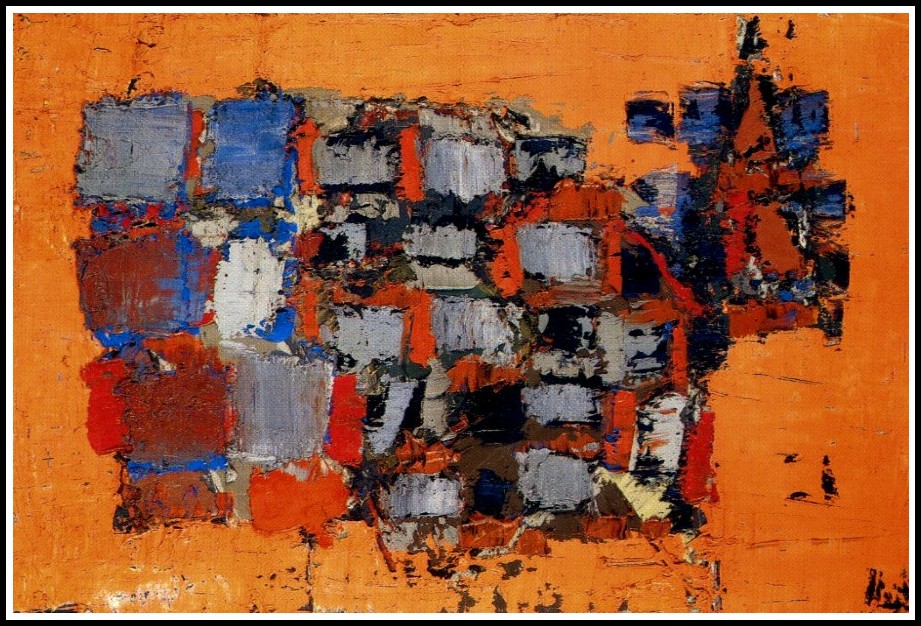
Nicolas de Staël, Composition sur fond rouge, 1951
4. ANTON WEBERN, FIVE PIECES FOR ORCHESTRA, OP. 10 (1913)
These five pieces continue to explore the apparent infinity of nuance which Webern manages to express within the softest possible dynamic level and the shortest possible space of time. The whole set lasts just over six minutes and the fourth piece is only six bars and fifteen seconds long. In spite of their brevity – or perhaps partly because of it – these miniatures form one of the most flawless pieces of music ever written, conveying much by means of the least, and with a restraint which is far more telling than any amount of rhetoric.
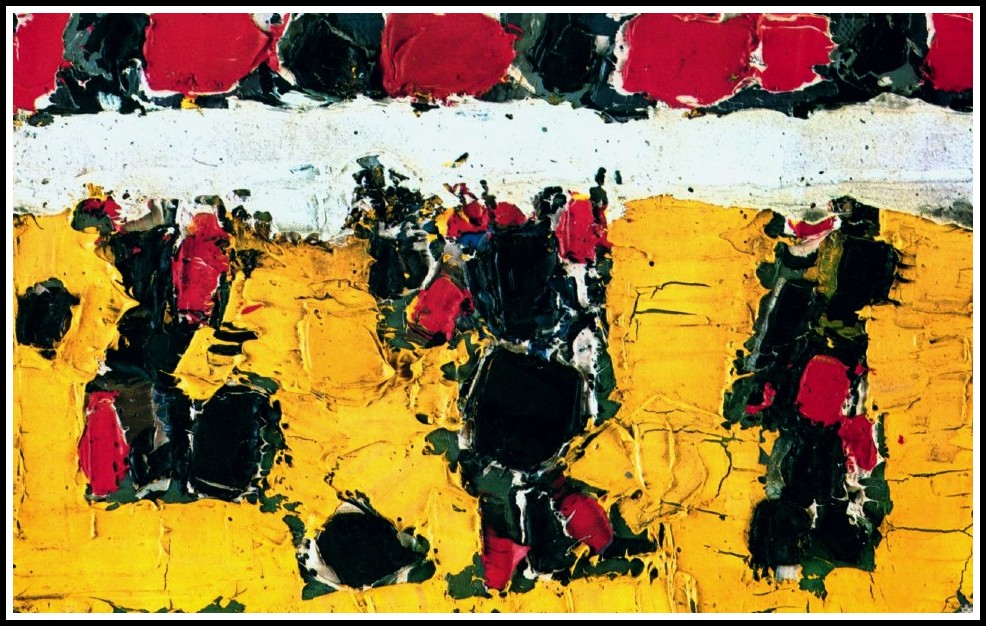
Nicolas de Staël, Parc des Princes, 1952 (according to Jean Pierre Jouffroy, La Mesure de Nicolas de Staël, p.123)
5. ANTON WEBERN, SYMPHONY, OP. 21 (1928)
This was the first work for comparable forces which Webern had written since the Five Pieces, Op. 10, completed fifteen years earlier. It marks the beginning of a preoccupation with stylistic compression which was to last for the rest of his life – a process of ‘distillation’ which culminates in the Variations, Op. 30.
The first movement of the Symphony divides into two parts – statement and development, each of which is repeated – and evolves entirely from canonic imitations of a theme which itself includes its own mirror version. These ‘imitations of imitations’ overlap in layers, tracing through the orchestra to form a continuous line of fragmentarily-disposed instrumental sounds.
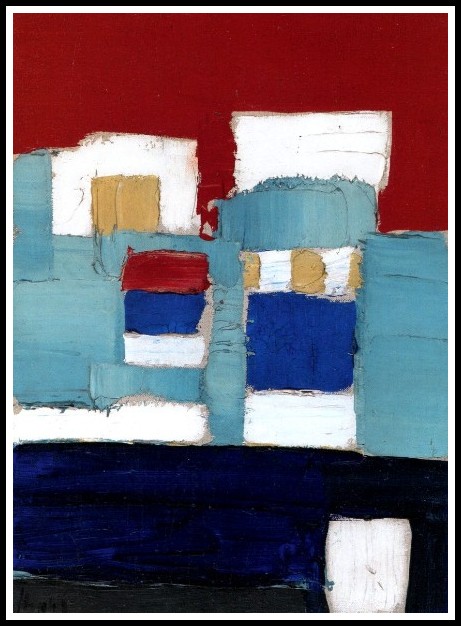
Nicolas de Staël, Composition-paysage, 1953
The second movement consists of a theme, seven variations and a coda, with each of the canonic variations working backwards from a central point to create an exactly symmetrical mirror image of itself:
Theme – scored for clarinet, echoed in canon by horns and harp.
Var. 1 – muted strings take up the rhythmical idea suggested in the theme.
Var. 2 – scored for the whole orchestra, three-note groups mirror each other within the total mirror-image – contrasting staccato and legato, piano and forte articulation.
Var. 3 – the horn sets up a rhythmic pattern, against which clarinets, harp and strings complete the canonic outline.
Var. 4 – the three-note rhythm in augmentation, partially contradicted by the two-note phrase accents on clarinets, horns and strings.
Var. 5 – cross-accentuation continues to develop more complex rhythmical relationships between harp and strings.
Var. 6 – an angular march for clarinets and horn.
Var. 7 – a tutti variation on the rhythmic variations of two- and three-note groups.
Coda – the orchestra is scaled down to a trio of violin, cello and harp, conclusively emphasizing the canonic double-image by means of the silences which form part of the symmetry.
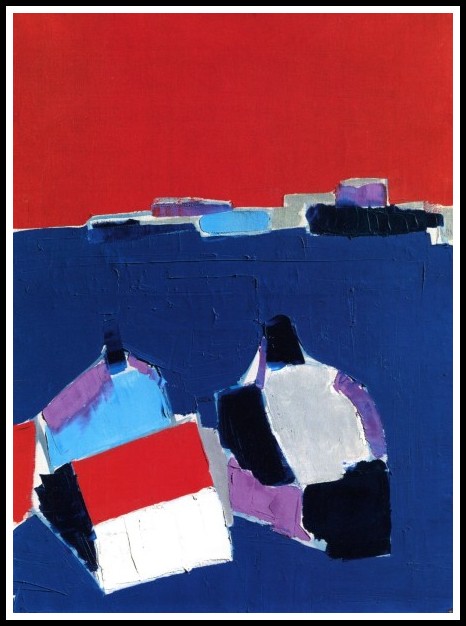
Nicolas de Staël, Marseille, 1954
6. ANTON WEBERN, TWO SONGS, OP. 19 (1926)
These songs are the last of the settings for voice(s) and instruments which occupied Webern for nearly ten years – as if in preparation for the final group of great, mainly instrumental works. The first song explores the rarefied harmonic world of characteristically disjunct intervals by means of the matching rhythmic ‘dissonance’ developed in Op. 18 – by dividing the pulse of the music into two and three/four and six, and by mixing and superposing these opposites. It also highlights the contrast between chorus and instruments (which here play a subsidiary but independently important part) and between the two groups of players: celesta and guitar, and violin, clarinet and bass clarinet. The second song is more rhythmically unified, with the staccato accentuation of the accompaniment set against the mainly legato phrasing of the vocal lines.
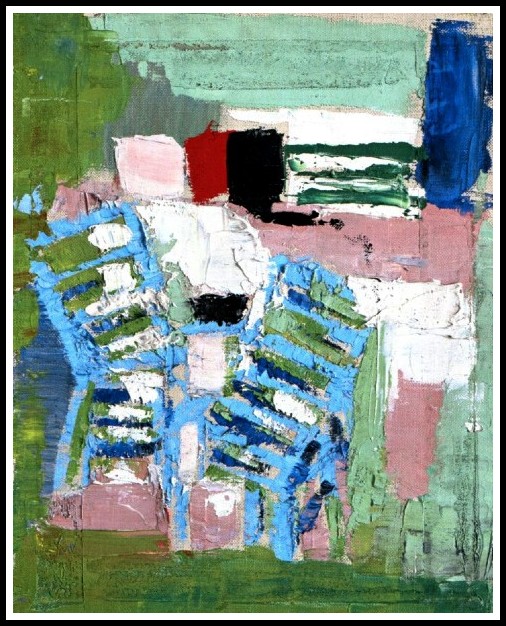
Nicolas de Staël, Le Lavandou, 1952
Two Songs on texts by Goethe
Zwei Lieder nach Goethe
I
Wess wie Lilien, reine Kerzen,
Sternen gleich, bescheidner Beugung,
leuchtet aus dem Mittelherzen
rot gesäumt die Glut der Neigung.
So frühzeitige Narzissen
bluhen reihenweis im Garten.
Mögen wohl die guten wissen,
wen sie so spaliert erwarten.
II
Ziehn die Schafe von der Wiese,
liegt sie da, ein reines Grün;
aber bald zum Paradiese
wird sie bunt geblümt erblühn.
Hoffnung breitet leichte Schleier
nebelhaft vor unsern Blick:
Wunscherfüllung, Sonnenfeier,
Wolkenteilung bring’ uns Gluck!
Two Songs on texts by Goethe
I
White, like lilies, pure candles,
star-like, with modest mien,
shines from the core of the heart
red-hemmed the glow of affection.
Thus the early narcissus
blooms in rows in the garden.
Let’s hope the dear ones know
for whom they stand so expectantly at attention.
II
When the sheep have left the meadow
it lies there a pure green;
but soon it will bloom
into a colorfully-flowered paradise.
Hope spreads light veils
mist-like before our glance:
wish-fulfillment, sun-feast,
parting clouds may bring us luck!
Deux Lieder sur des textes de Goethe
I
Blanche comme les lis, pures bougies,
pareille aux étoiles, la mine modeste,
reluit du fond du cœur,
ourlée de rouge, la flamme de l’inclination.
Ainsi les narcisses précoces
fleurissent par rangées dans le jardin.
Souhaitons que les bons sachent
qu’ils attendent ainsi en espalier.
II
Quand les brebis ont quitté la prairie,
elle est là, un vert pur;
mais bientôt en un paradis
elle fleurira multicolore.
L’espoir déploie des voiles légers
comme un brouillard devant notre regard:
l’accomplissement de nos vœux, la fête du soleil,
les nuages qui se dissipent nous apportent le bonheur!
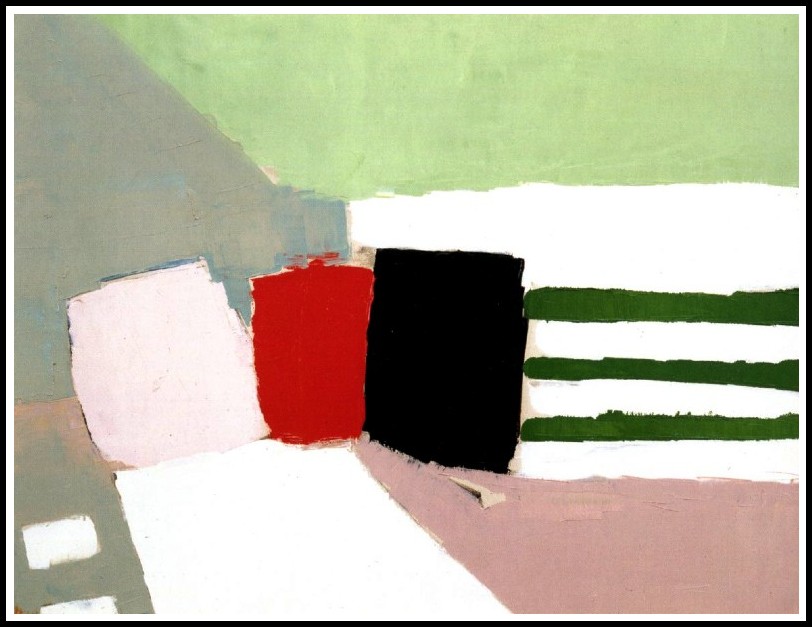
Nicolas de Staël, Nice, 1953
7. ANTON WEBERN, VARIATIONS FOR ORCHESTRA, OP. 30 (1940)
Of all Webern’s works, these Variations are perhaps the most perfect in the intense concentration of their form and expression: the theme and its six variations last only as many minutes and are played without a break.
The Theme is a four-note phrase (two semitones, separated by a minor third) with an uneven rhythmic shape (one note always being shorter than the other three). This is first stated by the double basses and then re-articulated in different guises throughout the orchestra – so that the theme is itself a set of miniature variations. Punctuating chords (first on pizzicato strings and later the brass) form the main impulse for:
Variation 1, in which a sustained melodic line is passed from one instrument or instrumental group to another – while repeated staccato chords form a pulsating background on each section of the orchestra (strings, woodwind, celesta and harp, brass) in turn. The tempo – which in the theme was controlled by the character of each motivic variant – is here static over longer periods: the faster tempo being linked to a forte dynamic and the slower to pianissimo.
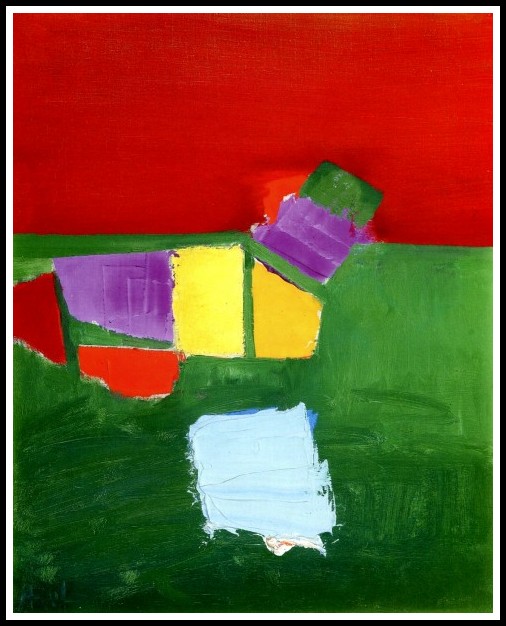
Nicolas de Staël, Martigues, 1954
Variation 2 grows out of the alternation of sustained and staccato four-note chords. Here, too, the four orchestral groups are treated as separate units – apart from the one moment when a solo violin completes a chord on the brass. The tempo is again linked to the dynamics, but, as the tempo is now basically fast, the dynamic level is reduced only at the cadential phrase-endings. The last two bars (on clarinet and violin) are a pre-echo of:
Variation 3, to which, strictly speaking, they belong. Here, there are two different strands: one slow-moving, with the contours of each four-note phrase often widely separated by rests; the other based on recurring groups of three evenly-spaced notes, the fourth being stated in isolation (either before or after) elsewhere in the orchestra. There is also the ‘foreign’ element of a dotted-note figure which takes over the punctuating function of the chords which outlined the shape of the Theme.
Variation 4 is a reprise of the main theme.
Variation 5, a miniature scherzo, is both the shortest and the most disjunct; the rhythmic motif is scattered across the orchestra in fragmentary counterpoints alternating with four-part chords.
In Variation 6 the rhythmic shapes are so widely stretched as to be barely recognizable – except when the tempo quickens at the climaxes. Punctuating chords on muted brass match the remoteness of this final metamorphosis, and the work concludes with a silent pause preceding the abruptly fractured cadence.
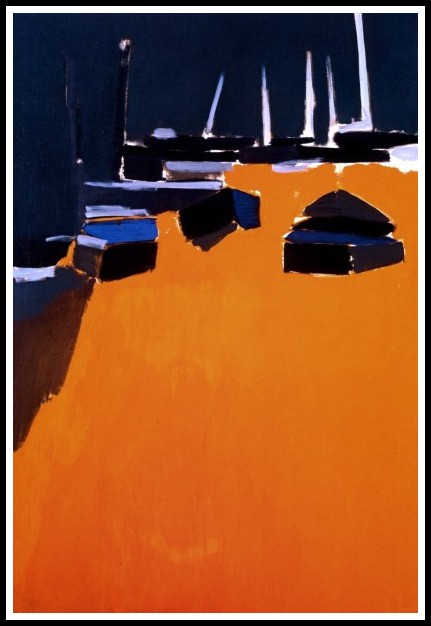
Nicolas de Staël, Martigues, 1954
MARA, MARIETTA: A LOVE STORY IN 77 BEDROOMS – READ THE FIRST CHAPTER
A literary novel by Richard Jonathan
Richard Jonathan, Mara, Marietta: A Love Story in 77 Bedrooms – Read the first chapter
MARA, MARIETTA: A LOVE STORY IN 77 BEDROOMS
A literary novel by Richard Jonathan
AMAZON & APPLE BOOKS
Richard Jonathan, Mara, Marietta: A Love Story in 77 Bedrooms | Amazon paperback or Kindle
Richard Jonathan, Mara, Marietta: A Love Story in 77 Bedrooms | Apple iBook
PAINTING IN ‘MARA, MARIETTA’
CLICK ON AN IMAGE TO GO TO THE CORRESPONDING PAGE
By Richard Jonathan | © Mara Marietta Culture Blog, 2022 | All rights reserved
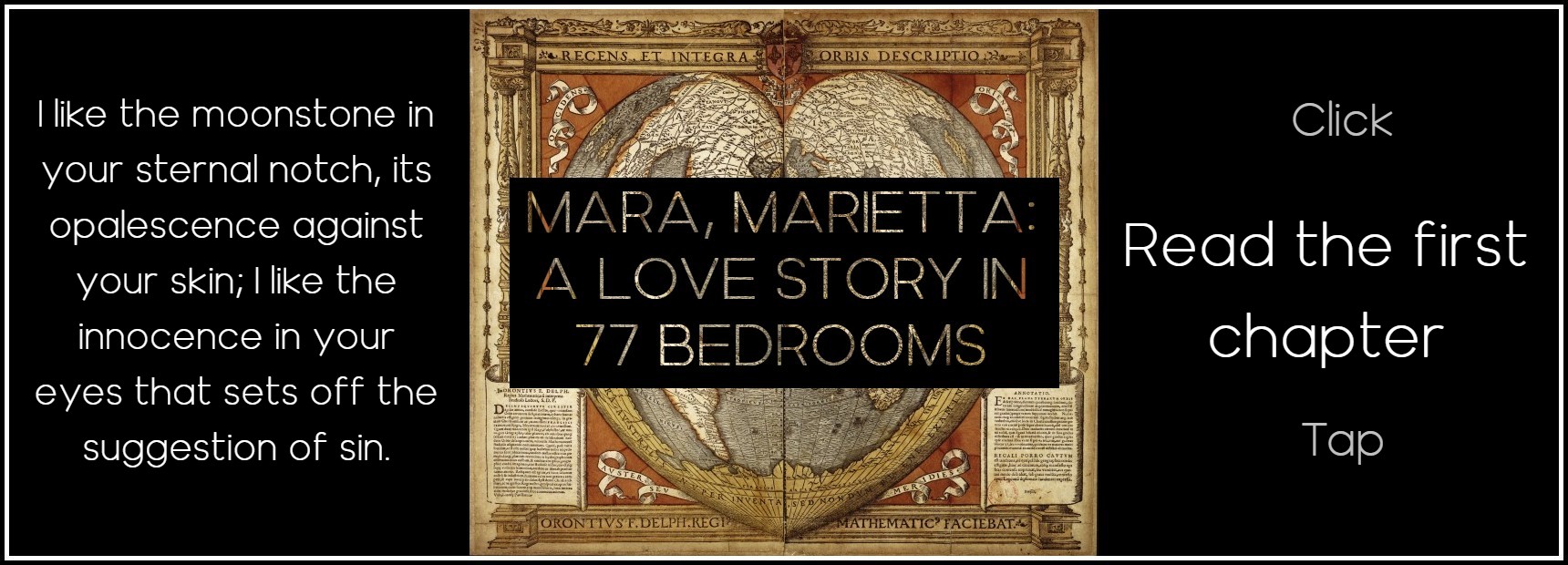

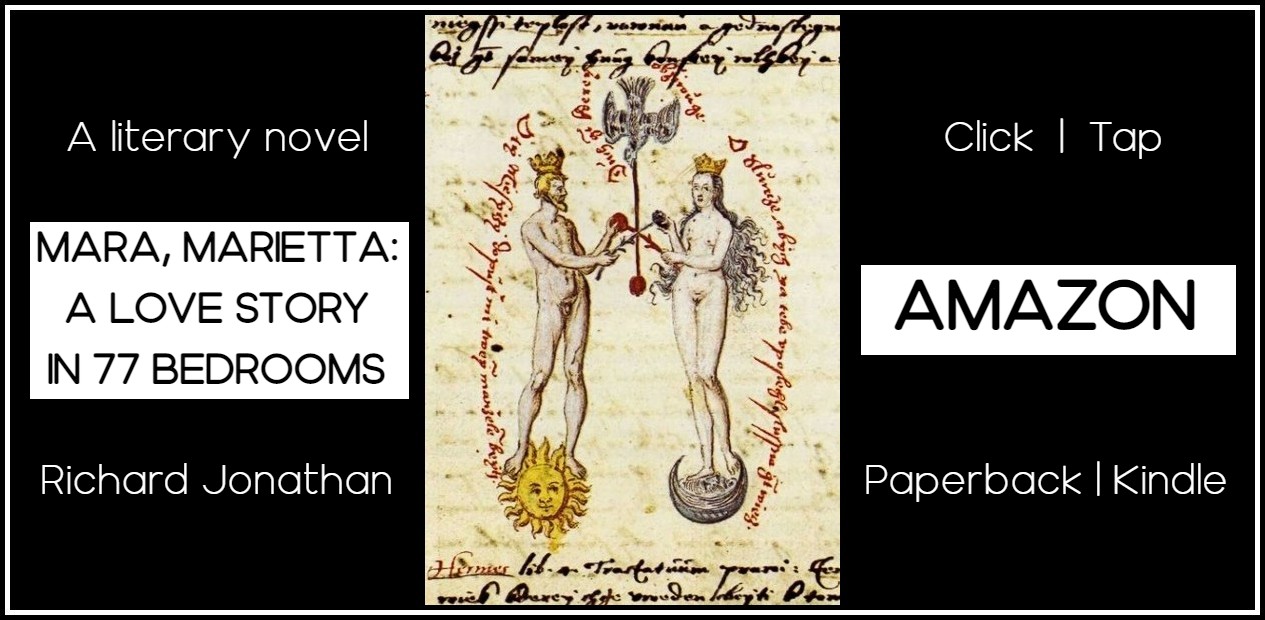
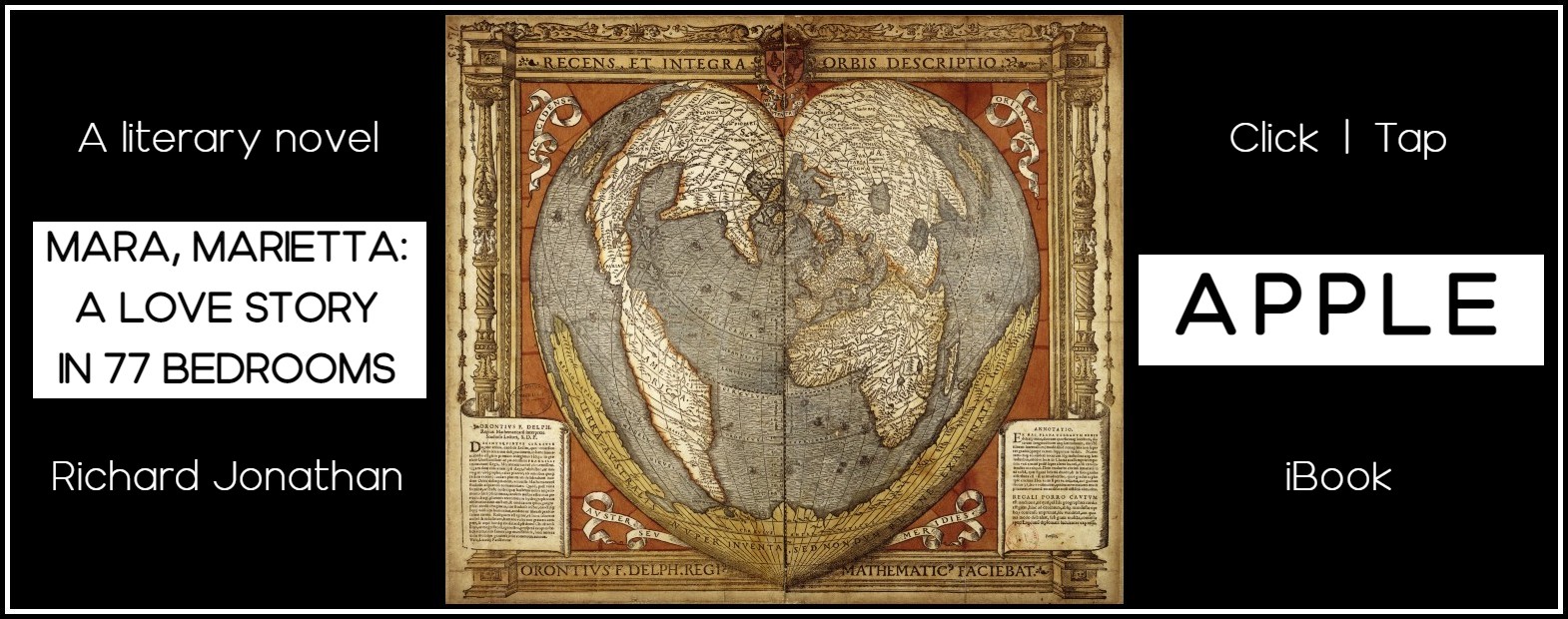
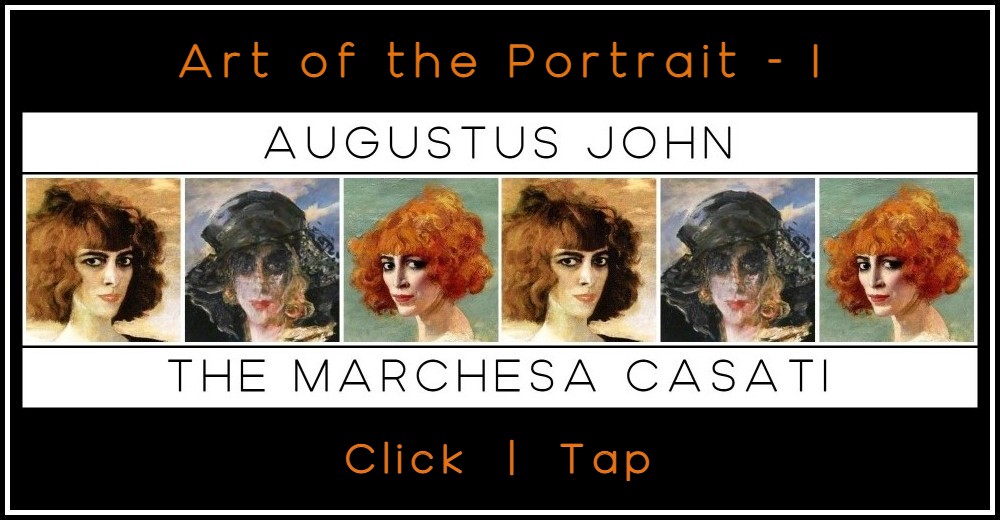
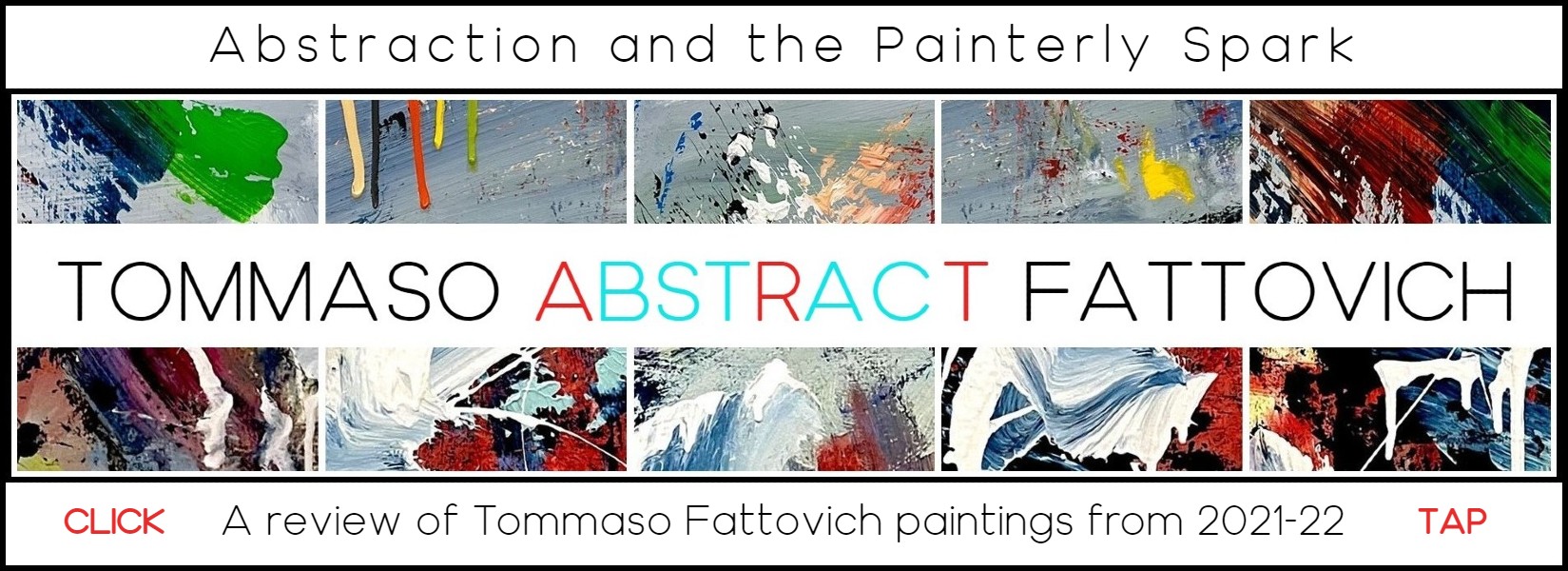
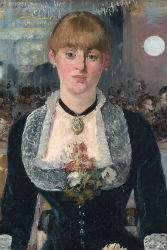
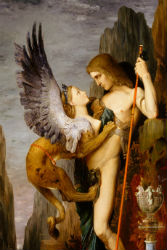
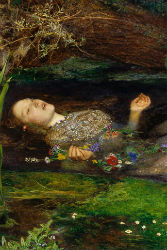
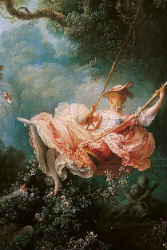
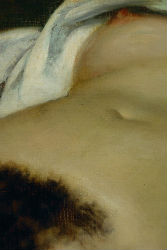
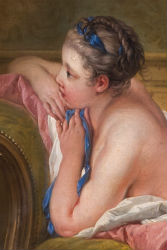
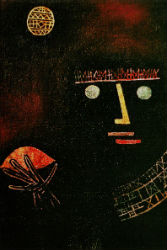
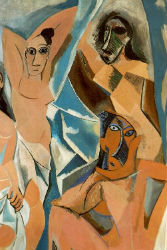
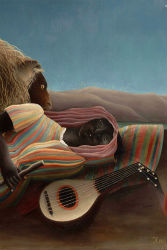
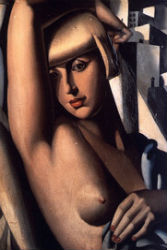
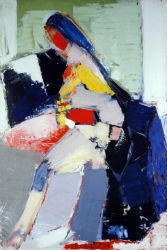
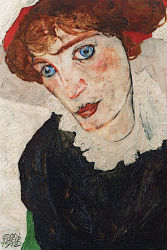
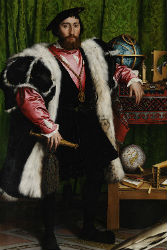
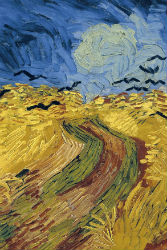
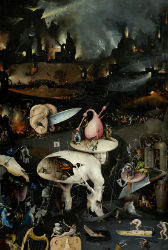
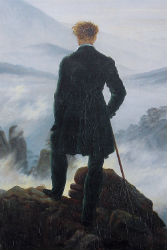
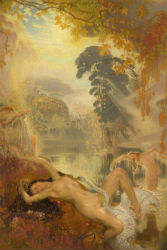
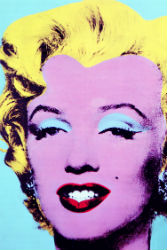
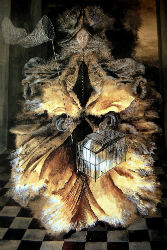
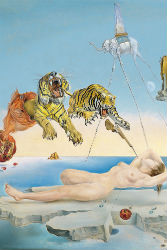
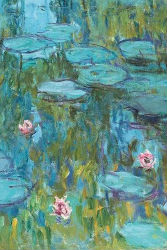
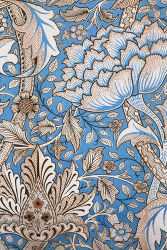
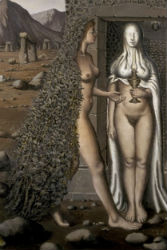
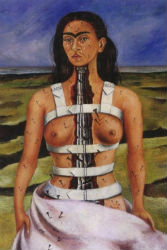
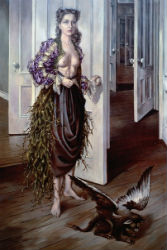
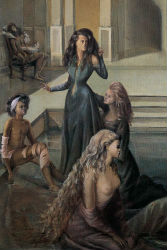
Comments